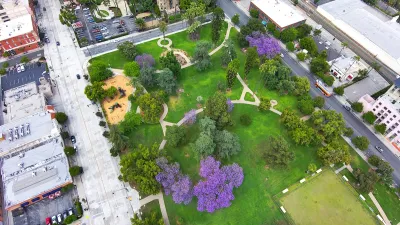On Places, D.J. Waldie assesses iconic aerial photographs of Lakewood, California, one of the nation's first postwar planned communities.
"In early 1950, William A. Garnett began flying over six square miles of former lima bean fields 23 miles southeast of downtown Los Angeles," writes Waldie, who is the author of the classic memoir Holy Land, about growing up in Lakewood. When the 17,500-house tract development was completed in 1954, it changed the map of Southern California forever.
Waldie explores the complex relationship between the aerial view and the postwar suburban boom, a relationship at once materialistic and transcendent. "Although the photographs were factually out-of-date as soon as the prints were dry," he says, "the anxieties they evoked became perfectly timeless."
The essay for Places includes a gallery of 20 photographs, by Garnett and others.
FULL STORY: Beautiful and Terrible: Aeriality and the Image of Suburbia

Trump Administration Could Effectively End Housing Voucher Program
Federal officials are eyeing major cuts to the Section 8 program that helps millions of low-income households pay rent.

Planetizen Federal Action Tracker
A weekly monitor of how Trump’s orders and actions are impacting planners and planning in America.

Ken Jennings Launches Transit Web Series
The Jeopardy champ wants you to ride public transit.

California Invests Additional $5M in Electric School Buses
The state wants to electrify all of its school bus fleets by 2035.

Austin Launches $2M Homelessness Prevention Fund
A new grant program from the city’s Homeless Strategy Office will fund rental assistance and supportive services.

Alabama School Forestry Initiative Brings Trees to Schoolyards
Trees can improve physical and mental health for students and commnity members.
Urban Design for Planners 1: Software Tools
This six-course series explores essential urban design concepts using open source software and equips planners with the tools they need to participate fully in the urban design process.
Planning for Universal Design
Learn the tools for implementing Universal Design in planning regulations.
Ada County Highway District
Clanton & Associates, Inc.
Jessamine County Fiscal Court
Institute for Housing and Urban Development Studies (IHS)
City of Grandview
Harvard GSD Executive Education
Toledo-Lucas County Plan Commissions
Salt Lake City
NYU Wagner Graduate School of Public Service





























